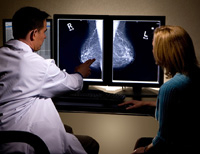Breast Cancer Precaution: Study
Three drugs reduce a woman's chance of getting breast cancer, but each drug carries distinct potential harms of its own, according to a new report from HHS' Agency for Healthcare Research and Quality.

Drugs to lessen the risk of breast cancer can be prescribed to women with a family history of breast cancer or other risk factors, but prescribing practices differ from each other. The comparative effectiveness review found that all three drugs -- tamoxifen, raloxifene, and tibolone -- significantly reduce invasive breast cancer in midlife and older women but that benefits and adverse effects can vary depending on the drug and the patient.
"Taking medicine to avoid breast cancer in the first place is an attractive notion, but the decision to do so must be made by patients in consultation with their clinicians with benefit of the best evidence available," said AHRQ Director Carolyn M. Clancy, M.D. "These drugs are not necessarily for everyone. This report sheds important light on their advantages and potential harms."
The report is the first to make a direct, comprehensive comparison of the drugs so that women and their health care providers can assess the medications' potential effectiveness and adverse effects. The report compares
the use of the three drugs to reduce the risks of getting breast cancer in women who have not previously had breast cancer.
Breast cancer is the second most commonly diagnosed cancer of women (after skin cancer), with more than 190,000 new cases diagnosed each year in the United States. It is estimated to cause more than 40,000 deaths per year. The National Cancer Institute estimates that nearly 15 percent of women born today will develop breast cancer in their lifetimes. Most cases of breast cancer occur in women with no specific risk factors other than age and gender, although family history of breast and ovarian cancer is associated with higher risk, according to Reuters' report.
Subscribe to Pravda.Ru Telegram channel, Facebook, RSS!




